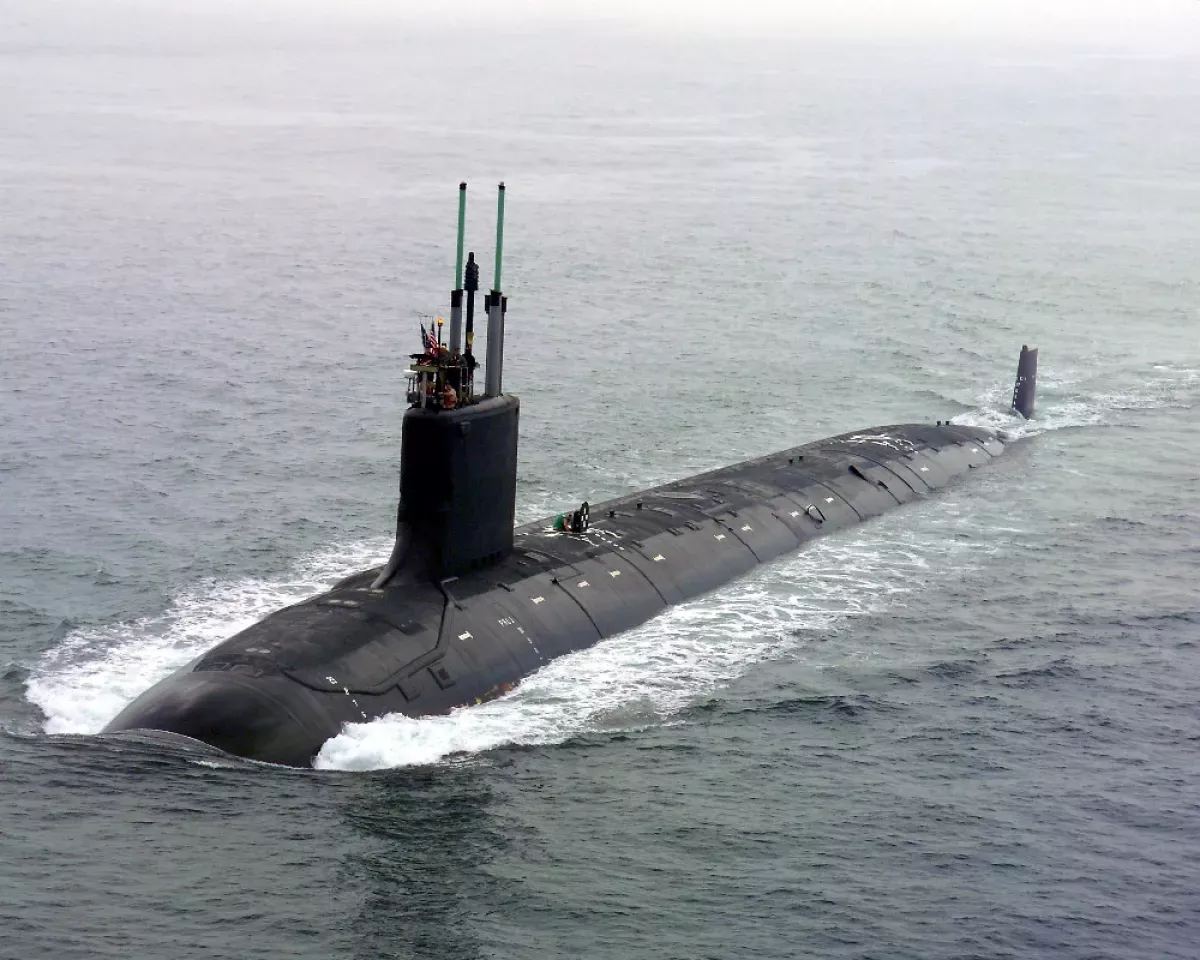A submarine is a watercraft capable of independent operation underwater, distinct from a submersible with limited underwater capabilities. While historically or colloquially used for remotely operated vehicles and smaller vessels like midget submarines, the term generally refers to larger, independently operating vessels. Despite their size, submarines are categorized as boats.
April 1900: United States Navy Commissions First Submarine
In April 1900, the United States Navy commissioned its first submarine, the USS Holland, marking a significant milestone in U.S. naval history.
June 1900: French Submarine Narval Commissioned
The French Navy commissioned the Narval in June 1900, a submarine featuring a groundbreaking double-hull design, showcasing advancements in submarine technology.
1901: Royal Navy Commissions Holland-Class Submarines
The Royal Navy commissioned five Holland-class submarines from Vickers, Barrow-in-Furness, between 1901 and 1903, expanding their submarine fleet.
April 1902: Royal Navy Conducts First Diving Trial
The Royal Navy conducted its first diving trial of a Holland-class submarine on April 6, 1902, marking a significant step in the development of the Royal Navy's submarine capabilities.
1903: Royal Navy Continues Commissioning Submarines
The Royal Navy continued expanding its fleet of submarines, completing the commissioning of five Holland-class submarines by 1903.
1904: Advancements in Submarine Technology
By 1904, diesel-electric propulsion became the leading power source for submarines, and the periscope became a standard piece of equipment, marking a pivotal period in submarine development.
1904: French Submarine Aigrette Improves Design
The French submarine Aigrette, launched in 1904, further enhanced submarine design by incorporating a diesel engine for surface power, increasing efficiency and range.
1904: Russo-Japanese War Begins
The Russo-Japanese War, which began in 1904, saw the first use of submarines in a major conflict, highlighting their evolving role in naval warfare.
1904: HMS Hajen: Pioneering Features in Submarine Design
The launch of HMS Hajen in 1904 marked a significant step in submarine technology. This Swedish submarine incorporated several innovative features, including a periscope, a semi-diesel engine (later replaced with a true diesel engine), and a decoupled powertrain with a dedicated generator. These advancements laid the groundwork for future submarine designs.
January 1905: World's First Operational Submarine Fleet
By January 1905, Russia assembled the world's first "operational submarine fleet" in Vladivostok, demonstrating the growing importance of submarine warfare.
April 1905: First Confrontation Between Submarine and Warships
The first recorded confrontation between a submarine and Japanese warships occurred on April 29, 1905, marking an early instance of submarine warfare tactics.
August 1914: First Submarine War Patrol in History
In August 1914, a German U-boat flotilla embarked on the first submarine war patrol in history, targeting Royal Navy warships in the North Sea and marking a significant development in naval warfare.
1914: France Constructs Numerous Submarines
By 1914, France had built a significant fleet of submarines, with seventy-six completed, highlighting their strategic importance in naval warfare.
1914: World War I Begins
The use of submarines in naval warfare expanded significantly with the outbreak of World War I in 1914.
1918: World War I Ends
The widespread use of submarines in World War I, which ended in 1918, demonstrated their significance in naval warfare, solidifying their role in future conflicts.
1928: US Navy Explores Diesel-Electric Transmission
The US Navy's Bureau of Engineering proposed using diesel-electric transmission for submarines in 1928, marking an early adoption of this technology. This innovation aimed to improve efficiency and operational flexibility for underwater operations.
1940: German Navy Experiments with Hydrogen Peroxide Propulsion
In 1940, the German Navy began testing a hydrogen peroxide-based propulsion system, known as the Walter turbine, on the experimental V-80 submarine. This marked an important step in developing air-independent propulsion (AIP) systems for submarines, aiming to increase underwater endurance.
December 1941: Japanese Attack on Pearl Harbor
At the time of the Japanese attack on Pearl Harbor in December 1941, the US Navy had 111 submarines in commission, highlighting the significant role submarines played in the Pacific Theater during World War II.
1945: Post-War Rise of Diesel-Electric Submarines
Following World War II, diesel-electric transmission gradually became the dominant propulsion system for conventional submarines. This shift reflected the technology's advantages in efficiency, noise reduction, and underwater endurance.
July 1953: First Cruise Missile Launch From a Submarine
The first successful launch of a cruise missile from a submarine took place in July 1953, marking a significant advancement in submarine capabilities and naval warfare tactics.
May 1957: US Navy's X-1: Experimental Hydrogen Peroxide Submarine
The US Navy experimented with hydrogen peroxide as a submarine fuel in the X-1, a midget submarine. However, an explosion in May 1957, involving the hydrogen peroxide supply, led to the submarine's conversion to diesel-electric drive. This incident highlighted the potential dangers associated with this volatile fuel.
1958: British Explorer-Class Submarine with AIP
Building on earlier German research, the British Navy launched the Explorer-class submarine in 1958, equipped with a hydrogen peroxide-based AIP system. This technology significantly extended the submarine's underwater endurance, demonstrating the viability of AIP for submarine propulsion.
October 1959: Trieste Begins its Journey to the Deep
The deep-submergence vehicle (DSV) Trieste embarked on its historic mission to the Mariana Trench in October 1959, departing San Diego for Guam aboard the freighter Santa Maria. This marked the beginning of Project Nekton, aiming to explore the deepest parts of the ocean.
1959: First Ballistic Missile Submarines Deployed by the US
As part of the Cold War nuclear deterrent strategy, the United States deployed its first ballistic missile submarines in 1959, marking a significant escalation in the Cold War arms race.
1959: Disneyland's Submarine Voyage Opens
While not a true submarine, Disneyland's Submarine Voyage ride, which opened in 1959, captivated the public's imagination and introduced the concept of underwater voyages to a wider audience.
January 1960: Trieste Reaches Challenger Deep
In a groundbreaking achievement, the DSV Trieste, manned by Jacques Piccard and Don Walsh, reached the Challenger Deep, the deepest known point on Earth, in January 1960. This marked the first time a vessel had reached such depths, opening new frontiers in deep-sea exploration.
1960: First Ballistic Missile Submarines Deployed by the Soviet Union
The Soviet Union followed the United States' lead in 1960, deploying its own fleet of ballistic missile submarines, further escalating Cold War tensions and the arms race.
1961: Soviet Submarine K-19 Reactor Accident
The Soviet submarine K-19 experienced a serious reactor accident in 1961, resulting in eight fatalities and exposing over 30 crew members to high radiation levels. This incident highlighted the inherent risks associated with nuclear propulsion in submarines and the importance of safety protocols.
1964: Auguste Piccard: The First Tourist Submarine
Marking a significant milestone in underwater tourism, 1964 saw the launch of Auguste Piccard, the world's first tourist submarine, at Expo64. This event paved the way for a new form of exploration and entertainment.
1967: Swedish Navy Pioneers the X-Stern
In 1967, the Swedish Navy launched the Sjöormen class submarine, the first to use an x-stern rudder configuration in standard operations. This innovative design, initially tested on the USS Albacore, offered significant maneuverability advantages and influenced subsequent submarine designs.
1968: Soviet Submarine K-27 Reactor Accident
Another severe reactor accident occurred on the Soviet submarine K-27 in 1968, leading to nine fatalities and 83 injuries. This incident further emphasized the potential dangers of nuclear propulsion in submarines and the need for rigorous safety measures.
1968: Soviet Submarine K-129 Lost
The Soviet Union lost the submarine K-129 in 1968, a portion of which was later salvaged by the CIA, highlighting the risks associated with submarine warfare during the Cold War.
1970: Soviet Submarine K-8 Lost
The loss of the Soviet submarine K-8 in 1970 further underscored the dangers inherent in Cold War submarine operations.
1971: First Submarine Sinkings Since World War II
The year 1971 witnessed the first submarine sinkings since World War II during the Indo-Pakistani War, marking a resurgence of submarine warfare.
1980: Soviet Navy Adopts Diesel-Electric Transmission
Despite its earlier dominance in other areas of submarine technology, the Soviet Navy only introduced diesel-electric transmission for its conventional submarines in 1980 with the Paltus class. This adoption highlighted the technology's widespread recognition as the standard for non-nuclear submarines.
1982: Falklands War: HMS Conqueror sinks ARA General Belgrano
In 1982, during the Falklands War, the British nuclear-powered submarine HMS Conqueror sank the Argentine cruiser General Belgrano. This event highlighted the significant advantage of submarines in warfare, showcasing their stealth and ability to cripple surface fleets.
1982: First Sinking by a Nuclear-Powered Submarine in War
The sinking of the Argentine cruiser General Belgrano by the British submarine HMS Conqueror in 1982 during the Falklands War marked the first instance of a nuclear-powered submarine sinking a vessel during wartime, highlighting the changing nature of naval warfare.
1983: Sweden Allows Women in Submarines, Except Pregnant Women
In 1983, Sweden opened most submarine service roles to women, with the exception of pregnant women due to health concerns, reflecting a move towards greater inclusivity while acknowledging specific risks.
1985: Royal Norwegian Navy Allows Women on Submarines
Breaking with longstanding tradition, the Royal Norwegian Navy became the first navy to allow women to serve on submarines in 1985. This decision marked a significant step towards gender equality in naval service.
1985: Soviet Submarine K-431 Accident
In 1985, the Soviet submarine K-431 suffered a major accident, resulting in ten fatalities and 49 radiation injuries. This incident highlighted the ongoing challenges of operating nuclear-powered submarines and the potential consequences of failures in safety procedures.
1986: Soviet Submarine K-219 Lost
The sinking of the Soviet submarine K-219 in 1986 served as a stark reminder of the potential consequences of accidents and tensions during the Cold War.
1988: HMS Näcken: Introduction of Stirling Engines for AIP
Continuing its tradition of innovation, the Swedish Navy launched HMS Näcken in 1988, equipped with Stirling engines for air-independent propulsion (AIP). This development further enhanced the submarine's underwater endurance, marking a significant advancement in non-nuclear submarine technology.
1988: Royal Danish Navy Allows Female Submariners
Following the lead of the Royal Norwegian Navy, the Royal Danish Navy opened its submarine service to women in 1988, further reflecting the growing trend of integrating women into all aspects of military service.
1989: Swedish Navy Allows Female Submariners
In 1989, the Swedish Navy made the decision to allow women to serve on submarines, joining a growing number of navies moving towards gender integration in their ranks.
1989: Soviet Submarine Komsomolets Sinks
The sinking of the Komsomolets, a Soviet submarine that held a depth record for military submarines, in 1989 highlighted the technical challenges and risks associated with deep-sea submarine operations during the Cold War.
1993: US Navy Allows Women on Surface Ships
In 1993, the US Navy began allowing women to serve on surface ships, marking a significant step towards gender integration in the Navy.
1995: Solveig Krey Commands HNoMS Kobben
Marking a historic milestone for women in the submarine service, Solveig Krey of the Royal Norwegian Navy became the first female officer to command a military submarine in 1995. She assumed command of HNoMS Kobben.
1995: Revised Measurements of the Challenger Deep
More accurate measurements conducted in 1995 revealed that the Challenger Deep, the deepest point in the Mariana Trench, was slightly shallower than initially believed, measuring 10,911 meters deep.
1997: Growth of the Tourist Submarine Industry
By 1997, the tourist submarine industry experienced substantial growth, with 45 operational vessels worldwide. This expansion reflects the increasing public interest in underwater exploration and the development of more sophisticated and accessible submersible technology.
1998: Royal Australian Navy Allows Female Submariners
In 1998, the Royal Australian Navy joined the ranks of navies allowing women to serve on submarines, reflecting a global shift towards greater gender equality in naval forces.
1999: Spanish Navy Allows Female Submariners
The Spanish Navy opened its submarine service to women in 1999, signaling its commitment to gender equality and expanding opportunities for women in the naval forces.
2001: German Navy Allows Female Submariners
Continuing the trend of greater inclusivity, the German Navy began allowing women to serve on submarines in 2001, recognizing the valuable contributions of all genders in naval operations.
2002: Canadian Navy Allows Female Submariners
In 2002, the Canadian Navy made the decision to allow women to serve on submarines, joining other nations in embracing gender diversity in their submarine forces.
2009: US Navy Explores Allowing Women on Submarines
In 2009, senior US Navy officials initiated the process of allowing women to serve on submarines, signaling a potential policy shift with significant implications for gender integration in the Navy.
2010: US Navy Removes Ban on Women in Submarines
In 2010, the US Navy officially rescinded its policy prohibiting women from serving on submarines, paving the way for full integration of women in submarine service.
September 2011: Drug Smugglers and Narco-Submarines
September 2011 marked a concerning development in drug trafficking as Colombian authorities seized a sophisticated narco-submarine. This incident highlighted the increasing use of submersibles by criminal organizations to smuggle drugs and evade law enforcement.
December 2011: UK Lifts Ban on Women in Submarines
In December 2011, the UK announced it would lift its ban on women serving in submarines, starting in 2013, addressing previous concerns about carbon dioxide exposure but maintaining restrictions for pregnant women.
2011: US Navy Moves Towards Integrating Women on Submarines
Between 2011 and 2012, the US Navy began integrating women into submarine service, ending a long-standing policy and reflecting a commitment to greater inclusivity.
2011: First Female Submarine Officers Graduate in the US Navy
In 2011, the US Navy saw its first class of female submarine officers graduate, a significant milestone in the integration of women into submarine roles.
October 2013: US Navy Announces Integration of Women on Attack Submarines
In October 2013, the US Navy announced that women would be integrated into the crews of two Virginia-class attack submarines by January 2015, furthering the inclusion of women in submarine service.
May 2014: First Female Submariners in the Royal Navy
In May 2014, the first three women became submariners in the Royal Navy, marking a historic milestone in the integration of women in submarine service.
November 2018: Israeli Navy Discloses Sinking of Lebanese Vessel
In November 2018, the Israeli Navy disclosed the sinking of the Lebanese coaster Transit, which they believed was carrying anti-Israeli militias, in 1982 during the Lebanon War, sparking controversy and raising questions about the incident.
2020: Japan Accepts First Female Candidate into Naval Submarine Academy
In a landmark decision in 2020, Japan's national naval submarine academy accepted its first female candidate, signaling a significant step towards greater gender diversity in submarine forces.
Mentioned in this timeline
The Union of Soviet Socialist Republics USSR existed from to...

Disneyland located in Anaheim California is the first theme park...
Japan is an East Asian island country situated in the...
Virginia officially the Commonwealth of Virginia is a state located...
France officially the French Republic is primarily located in Western...
Lebanon is a country in the Levant region of West...
Trending

Ladd McConkey is a professional American football wide receiver currently playing for the Los Angeles Chargers He was drafted in...

18 days ago Deshaun Watson Returns to Browns Practice After Achilles Injury: 21-Day Window Opens

19 days ago Callum Turner: Rising Star and New Favorite for the Coveted James Bond Role
Matt Prater is a professional American football placekicker currently playing for the Buffalo Bills He is renowned for his exceptional...

2 months ago CeeDee Lamb's Potential Return and Prescott's Warning Highlighted
8 months ago Tre Harris: NFL Draft Prospect, Ole Miss Star, Igniting NFL Aspirations
Popular

Candace Owens is an American conservative political commentator and author...

Tucker Carlson is an American conservative political commentator known for...

XXXTentacion born Jahseh Dwayne Ricardo Onfroy was a controversial yet...

Ben Shapiro is a prominent American conservative political commentator media...

William Franklin Graham III commonly known as Franklin Graham is...

Bill Gates an American businessman and philanthropist revolutionized personal computing...
